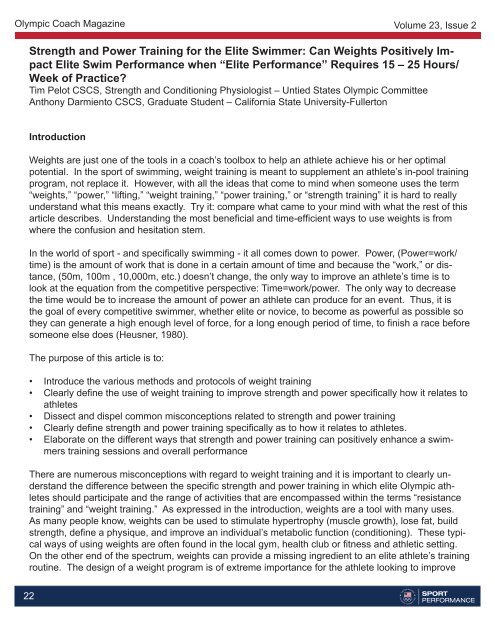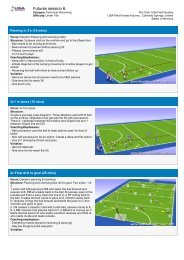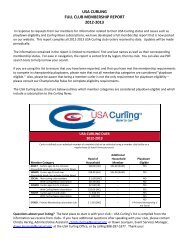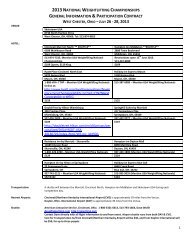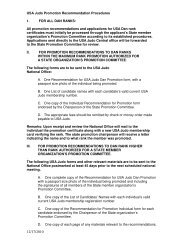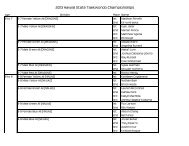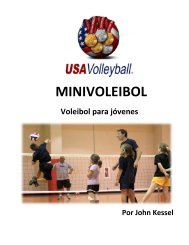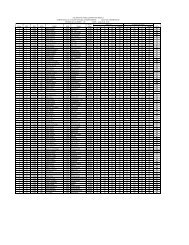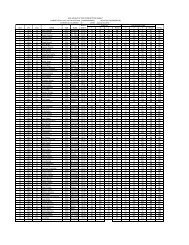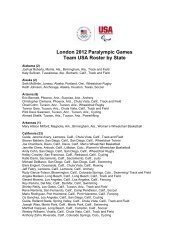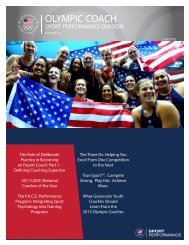Strength and Power for the Elite Swimmer 2012 - United States ...
Strength and Power for the Elite Swimmer 2012 - United States ...
Strength and Power for the Elite Swimmer 2012 - United States ...
Create successful ePaper yourself
Turn your PDF publications into a flip-book with our unique Google optimized e-Paper software.
Olympic Coach Magazine<br />
22<br />
Volume 23, Issue 2<br />
<strong>Strength</strong> <strong>and</strong> <strong>Power</strong> Training <strong>for</strong> <strong>the</strong> <strong>Elite</strong> <strong>Swimmer</strong>: Can Weights Positively Impact<br />
<strong>Elite</strong> Swim Per<strong>for</strong>mance when “<strong>Elite</strong> Per<strong>for</strong>mance” Requires 15 – 25 Hours/<br />
Week of Practice?<br />
Tim Pelot CSCS, <strong>Strength</strong> <strong>and</strong> Conditioning Physiologist – Untied <strong>States</strong> Olympic Committee<br />
Anthony Darmiento CSCS, Graduate Student – Cali<strong>for</strong>nia State University-Fullerton<br />
Introduction<br />
Weights are just one of <strong>the</strong> tools in a coach’s toolbox to help an athlete achieve his or her optimal<br />
potential. In <strong>the</strong> sport of swimming, weight training is meant to supplement an athlete’s in-pool training<br />
program, not replace it. However, with all <strong>the</strong> ideas that come to mind when someone uses <strong>the</strong> term<br />
“weights,” “power,” “lifting,” “weight training,” “power training,” or “strength training” it is hard to really<br />
underst<strong>and</strong> what this means exactly. Try it: compare what came to your mind with what <strong>the</strong> rest of this<br />
article describes. Underst<strong>and</strong>ing <strong>the</strong> most beneficial <strong>and</strong> time-efficient ways to use weights is from<br />
where <strong>the</strong> confusion <strong>and</strong> hesitation stem.<br />
In <strong>the</strong> world of sport - <strong>and</strong> specifically swimming - it all comes down to power. <strong>Power</strong>, (<strong>Power</strong>=work/<br />
time) is <strong>the</strong> amount of work that is done in a certain amount of time <strong>and</strong> because <strong>the</strong> “work,” or distance,<br />
(50m, 100m , 10,000m, etc.) doesn’t change, <strong>the</strong> only way to improve an athlete’s time is to<br />
look at <strong>the</strong> equation from <strong>the</strong> competitive perspective: Time=work/power. The only way to decrease<br />
<strong>the</strong> time would be to increase <strong>the</strong> amount of power an athlete can produce <strong>for</strong> an event. Thus, it is<br />
<strong>the</strong> goal of every competitive swimmer, whe<strong>the</strong>r elite or novice, to become as powerful as possible so<br />
<strong>the</strong>y can generate a high enough level of <strong>for</strong>ce, <strong>for</strong> a long enough period of time, to finish a race be<strong>for</strong>e<br />
someone else does (Heusner, 1980).<br />
The purpose of this article is to:<br />
• Introduce <strong>the</strong> various methods <strong>and</strong> protocols of weight training<br />
• Clearly define <strong>the</strong> use of weight training to improve strength <strong>and</strong> power specifically how it relates to<br />
athletes<br />
• Dissect <strong>and</strong> dispel common misconceptions related to strength <strong>and</strong> power training<br />
• Clearly define strength <strong>and</strong> power training specifically as to how it relates to athletes.<br />
• Elaborate on <strong>the</strong> different ways that strength <strong>and</strong> power training can positively enhance a swimmers<br />
training sessions <strong>and</strong> overall per<strong>for</strong>mance<br />
There are numerous misconceptions with regard to weight training <strong>and</strong> it is important to clearly underst<strong>and</strong><br />
<strong>the</strong> difference between <strong>the</strong> specific strength <strong>and</strong> power training in which elite Olympic athletes<br />
should participate <strong>and</strong> <strong>the</strong> range of activities that are encompassed within <strong>the</strong> terms “resistance<br />
training” <strong>and</strong> “weight training.” As expressed in <strong>the</strong> introduction, weights are a tool with many uses.<br />
As many people know, weights can be used to stimulate hypertrophy (muscle growth), lose fat, build<br />
strength, define a physique, <strong>and</strong> improve an individual’s metabolic function (conditioning). These typical<br />
ways of using weights are often found in <strong>the</strong> local gym, health club or fitness <strong>and</strong> athletic setting.<br />
On <strong>the</strong> o<strong>the</strong>r end of <strong>the</strong> spectrum, weights can provide a missing ingredient to an elite athlete’s training<br />
routine. The design of a weight program is of extreme importance <strong>for</strong> <strong>the</strong> athlete looking to improve
Olympic Coach Magazine<br />
23<br />
Volume 23, Issue 2<br />
ability while complementing <strong>the</strong>ir practice schedule. A sport-specific weight program can make athletes<br />
more powerful, improve movement patterns <strong>and</strong> stimulate <strong>the</strong> body <strong>and</strong> its tissue to become stronger<br />
<strong>and</strong> more resilient to <strong>the</strong> wear <strong>and</strong> tear of a dem<strong>and</strong>ing practice schedule (Layne, 1999 <strong>and</strong> MacDougall,<br />
1986), all of which can have a significant positive impact on an elite swimmer’s per<strong>for</strong>mance.<br />
The largest misconception related to weight training is that all weight training programs are <strong>the</strong> same<br />
<strong>and</strong> one can achieve different goals by training <strong>the</strong> same way. It is also incorrect to believe that just by<br />
incorporating weight training into an athlete’s routine that strength <strong>and</strong> power will improve. There are<br />
endless ways to create programs that are tailored to very specific goals. For example, here are four<br />
specific modifiable variables in any training program. They are volume, intensity, rest, exercise selection,<br />
<strong>and</strong> speed of exercise execution. One training program, “Program A,” could be designed with a<br />
very high volume (amount of total repetitions per training session) with low intensity (lighter loads of<br />
weight or resistance) <strong>and</strong> minimal rest periods. Ano<strong>the</strong>r training program, “Program B,” could be designed<br />
with very low volume with high intensity <strong>and</strong> longer rest periods. Below is an example of one<br />
exercise from <strong>the</strong>se two hypo<strong>the</strong>tical programs:<br />
Program A Program B<br />
Exercise One<br />
Three sets of 10 repetitions at100 lbs.<br />
Rest: 30 -60 seconds<br />
Approximate total work is<br />
3x10x100= 3000lbs<br />
Exercise One<br />
Three sets of 5 repetitions at150 lbs.<br />
Rest: Two minutes<br />
Approximate total work is 3x5x150=2250lbs<br />
Results Results<br />
<strong>Strength</strong> Gain = Moderate<br />
Muscle Gain = High<br />
Residual Fatigue Affect = High<br />
<strong>Strength</strong> Gain = High<br />
Muscle Gain = Low<br />
Residual Fatigue Affect = Low<br />
These two programs would elicit two very different adaptations from <strong>the</strong> body. Over a training period,<br />
Program B could serve to improve <strong>the</strong> strength <strong>and</strong> power of an athlete while not imposing <strong>the</strong> same<br />
amount of fatigue that is imposed on <strong>the</strong> athlete because of <strong>the</strong> decreased amount of work as compared<br />
to Program A. This would be advantageous to an elite athlete whose training fatigue is already<br />
relatively high due to sport-specific training. This simple variation in <strong>the</strong> volume <strong>and</strong> intensity of a<br />
workout program alone could help improve an athlete’s strength <strong>and</strong> power while reducing fatigue as<br />
compared to o<strong>the</strong>r programs.<br />
Something important to remember though is that Program A may still serve a purpose to a different<br />
elite athlete, at a different time of <strong>the</strong>ir training season, with different goals. This is precisely why it<br />
is important to realize that all weight training programs are not <strong>the</strong> same <strong>and</strong> that a program must be<br />
tailored based on an athlete’s past <strong>and</strong> present training experience <strong>and</strong> <strong>the</strong> athletes present <strong>and</strong> future<br />
goals.<br />
Ano<strong>the</strong>r misconception that often scares coaches <strong>and</strong> athletes is that to become stronger you must
Olympic Coach Magazine<br />
24<br />
Volume 23, Issue 2<br />
gain more muscle, <strong>and</strong> that all weight training stimulates muscle growth. It is important to realize that <strong>the</strong><br />
initial <strong>and</strong> long term improvements of strength can be improved without increase in muscle size (Sale,<br />
1992). Yes, more muscle can help improve strength <strong>and</strong> power, but is not always necessary. On <strong>the</strong><br />
o<strong>the</strong>r h<strong>and</strong>, if it is <strong>the</strong> specific goal of <strong>the</strong> athlete to increase lean body mass (muscle) a training program<br />
can be created to elicit such adaptations.<br />
Be<strong>for</strong>e we go any fur<strong>the</strong>r, here are very simple definitions of two very important factors - both critical to<br />
improving <strong>the</strong> per<strong>for</strong>mance of an <strong>Elite</strong> <strong>Swimmer</strong>:<br />
• <strong>Strength</strong>: <strong>the</strong> ability of <strong>the</strong> muscle to exert maximal <strong>for</strong>ce at a specified velocity (Knuttgen, 1987)<br />
• <strong>Power</strong>: The amount of work done in a specified time or <strong>the</strong> product of a <strong>for</strong>ce <strong>and</strong> velocity (Cronin,<br />
2005)<br />
To visualize <strong>the</strong> spectrum of different ways people use weights <strong>for</strong> training, <strong>the</strong> chart on <strong>the</strong> next page depicts<br />
different modes of weight training <strong>and</strong> characteristics of each mode. Notice how <strong>the</strong> characteristics<br />
between an elite Olympic sporting athlete differ from <strong>the</strong> four o<strong>the</strong>r modes.<br />
Per<strong>for</strong>mance Enhancement<br />
There are multiple ways that weight training can be beneficial to <strong>the</strong> per<strong>for</strong>mance of an elite Olympic<br />
swimmer. To underst<strong>and</strong> <strong>the</strong> various ways that weights can benefit an athlete of this level it is important<br />
to first describe <strong>the</strong> different ways in which per<strong>for</strong>mance can be “improved.” The obvious answer is that<br />
specific modes of weight training such as Olympic weightlifting movements (squatting movements, clean<br />
<strong>and</strong> jerk, snatch <strong>and</strong> modified variations of <strong>the</strong>se lifts) can make an athlete stronger <strong>and</strong> more powerful<br />
(Stone, 2005). The less obvious answer is that <strong>the</strong> stress imposed by weight training can stimulate<br />
adaptations in <strong>the</strong> body that will aid recovery from training sessions (Leite, 2011), <strong>and</strong> reduce <strong>the</strong> risk of<br />
injury to an athlete’s body associated with sport-specific training (Weil, 1999). With recovery improving<br />
<strong>and</strong> <strong>the</strong> likelihood of injury lower, an athlete will have <strong>the</strong> ability to train more frequently <strong>and</strong> at greater<br />
intensities. There is no doubt that this will allow an athlete to improve per<strong>for</strong>mance.<br />
Development of <strong>Strength</strong> <strong>and</strong> <strong>Power</strong><br />
It is commonly accepted that strength <strong>and</strong> power training can lead to <strong>the</strong> improvement of strength <strong>and</strong>
Olympic Coach Magazine<br />
25<br />
Fitness Enthusiast<br />
(gym member)<br />
Sets <strong>and</strong> repetitions 2-5 sets of 10-20<br />
repetitions<br />
Body Builder Typical Collegiate<br />
Football Athlete<br />
3-5 sets of 8-20<br />
repetitions<br />
3-5 sets of 3-12<br />
repetitions<br />
Focus Muscle based Muscle based Primarily<br />
movement based<br />
Purpose Self image <strong>and</strong><br />
aes<strong>the</strong>tics<br />
Loads Used Light to moderate Mostly moderate<br />
<strong>and</strong> some heavy<br />
Percentage of<br />
exercises focusing<br />
on maximal strength<br />
Percentage of<br />
exercises focused<br />
on explosive power<br />
Percentage of<br />
exercises focused<br />
on core strength<br />
Muscle aes<strong>the</strong>tics Per<strong>for</strong>mance of<br />
strength, power<br />
<strong>and</strong> size<br />
<strong>Elite</strong> Olympic<br />
Sporting Athlete<br />
3-6 sets of 0-8<br />
repetitions<br />
Volume 23, Issue 2<br />
Typical Weight Routine<br />
(3x10)<br />
3 sets of 10 repetitions<br />
Movement based Muscle based<br />
Per<strong>for</strong>mance of<br />
strength, power<br />
<strong>and</strong> durability<br />
Health <strong>and</strong><br />
cardiovascular<br />
wellness<br />
Moderate to heavy Moderate to heavy Light to moderate<br />
0% 0-10% 30-60% 30-40% 0%<br />
0% 0% 30-40% 45-55% 0%<br />
5% 10% 50% 60% 10%<br />
Fatigue Moderate High Moderate to high Low Low to moderate<br />
Amount of muscular<br />
damage<br />
Impact on reduced<br />
motor control<br />
Moderate High Moderate to high Moderate Moderate<br />
6 hrs 48-72 hrs 48-72 hrs 12-24 hrs 6 hrs<br />
Days per week 2-4 3-5 3-5 2-3 Varies<br />
# of exercises per<br />
muscle group<br />
Duration of lifting<br />
routine<br />
Fiber types recruited Primarily slow<br />
twitch<br />
Influence on<br />
explosive power<br />
Impact on muscular<br />
development<br />
General cortisol<br />
levels post-workout<br />
2-3 2-4 3-5 1-2 2-4<br />
60-90 min 90-120 min 90-120 min 30-60 min 60 min<br />
70% slow twitch;<br />
30% fast twitch<br />
Primarily fast twitch Primarily fast<br />
twitch<br />
Primarily slow twitch<br />
N/A N/A High High N/A<br />
Low to moderate High High Low Moderate<br />
Moderate to high High Moderate to high Low Moderate<br />
power even without an increase in muscle size (Sale, 1992). These improvements can be credited to an increase<br />
in <strong>the</strong> ability to recruit <strong>and</strong> synchronize <strong>the</strong> firing of motor units (muscle fibers) (Sale, 1992) <strong>and</strong> changes<br />
in intracellular factors such as myosin heavy chain composition <strong>and</strong> enzyme activity (Adams, 1993 <strong>and</strong><br />
Ha<strong>the</strong>r, 1991). To put it more simply, an athlete will be able to tap into more fibers, <strong>and</strong> improve synchronization<br />
of activation of each individual fiber leading to a larger <strong>for</strong>ce. Imagine each of <strong>the</strong> fibers were one person<br />
in a game of tug-of-war on <strong>the</strong> same team. If <strong>the</strong>y were to all “tug” at <strong>the</strong> same time it would create a more
Olympic Coach Magazine<br />
26<br />
Volume 23, Issue 2<br />
powerful <strong>for</strong>ce than if only one person would “tug” at a time. In addition, imagine that <strong>the</strong>re were some<br />
lazy people on <strong>the</strong> team that usually only chose to “tug” if <strong>the</strong> team were losing; <strong>the</strong>se teammates would<br />
be conditioned to tug in unison with <strong>the</strong> team from <strong>the</strong> very beginning of <strong>the</strong> game leading to an overall<br />
much more powerful “tug.” The adaptation to <strong>the</strong> physical properties of <strong>the</strong> muscle fibers would be that<br />
<strong>the</strong> fibers <strong>the</strong>mselves would become stronger <strong>and</strong> <strong>the</strong> enzymes within <strong>the</strong> fiber would become more effective<br />
at initiating biochemical reactions.<br />
This use of strength training - <strong>and</strong> more specifically power training - can improve <strong>the</strong> rate of <strong>for</strong>ce development<br />
of <strong>the</strong> muscle, muscle groups, <strong>and</strong> overall athlete, which has been suggested to be a greater<br />
determinant of athletic success than just power alone (Newton <strong>and</strong> Kraemer, 1994).<br />
It is important to realize that within <strong>the</strong> human body movements are primarily a result of torques <strong>and</strong> <strong>the</strong><br />
magnitude of <strong>the</strong> torques will decrease with velocity (Heusner, 1980). There<strong>for</strong>e, at <strong>the</strong> elite level an<br />
athlete should not only train to be strong <strong>and</strong> generate large <strong>for</strong>ces, but train to develop a larger torque<br />
at high sport-specific velocities. A simple example would be to try <strong>and</strong> increase <strong>the</strong> speed of a moving<br />
object in <strong>the</strong> same direction. If <strong>the</strong> object is moving at a slow speed it will be easy to apply a <strong>for</strong>ce to <strong>the</strong><br />
object <strong>and</strong> accelerate it. But if <strong>the</strong> object is moving too fast, it may be too difficult to apply an impulse to<br />
<strong>the</strong> object to accelerate it. This is a simple example that can easily be applied to swimming. If an athlete<br />
has an improved rate of <strong>for</strong>ce development <strong>the</strong>n <strong>the</strong> athlete will be able to “catch” <strong>the</strong> water, begin<br />
generating torque <strong>and</strong> start applying <strong>for</strong>ce in a shorter amount of time, leading to greater acceleration of<br />
<strong>the</strong>ir body through <strong>the</strong> water. When an athlete does not possess a high rate of <strong>for</strong>ce development, an<br />
athlete will not be able to “catch” <strong>and</strong> “pull” water more quickly than <strong>the</strong>ir opponent.<br />
Ano<strong>the</strong>r important concept related to strength <strong>and</strong> power training of elite athletes is <strong>the</strong> focus on training<br />
movements, not muscles. Ra<strong>the</strong>r than focusing on <strong>the</strong> development of each muscle individually, a<br />
program that improves per<strong>for</strong>mance focuses on <strong>the</strong> training of movements, primarily pushing <strong>and</strong> pulling.<br />
Training <strong>the</strong> muscles of <strong>the</strong> extremities is secondary to training <strong>the</strong> muscles near <strong>the</strong> torso as <strong>the</strong><br />
muscles of <strong>the</strong> torso tend to have a greater ability to generate <strong>for</strong>ces that would help enhance athletic<br />
per<strong>for</strong>mance. An example of training a movement would be <strong>the</strong> use of an Olympic weightlifting move-
Olympic Coach Magazine<br />
27<br />
Volume 23, Issue 2<br />
ments would be <strong>the</strong> use of an Olympic weightlifting or modified Olympic weightlifting movement; such<br />
exercises promote high levels of activation of <strong>the</strong> core <strong>and</strong> promote improvements in <strong>the</strong> ability to generate<br />
power in a triple extension movement (extension of <strong>the</strong> hips, knees <strong>and</strong> ankles). Triple extension is a<br />
movement linked to many sports. In <strong>the</strong> sport of swimming, triple extension can be seen in “block starts”<br />
<strong>and</strong> <strong>the</strong> “push-off” from <strong>the</strong> wall. It has been suggested through findings that swimmers need to incorporate<br />
lower body strength <strong>and</strong> power training into <strong>the</strong>ir workouts to improve sprint swim starts as <strong>the</strong><br />
start has a considerable correlation to competition success (West). An athlete gains a greater advantage<br />
when <strong>the</strong>y generate more power from <strong>the</strong> block start or a push off on a turn.<br />
Integrating exercises that require multiple muscle groups to contract simultaneously under resistance<br />
during various planes of motion can create improvements in <strong>the</strong> body’s neural network. This network<br />
serves as a plat<strong>for</strong>m that enables greater transfer of strength <strong>and</strong> power into movements per<strong>for</strong>med in<br />
<strong>the</strong> pool. This increased neural control <strong>and</strong> coordination while moving under sport resistance (water)<br />
may not improve a swimmers kines<strong>the</strong>tic awareness (feel of <strong>the</strong> water on <strong>the</strong> body), but <strong>the</strong> increased<br />
neural-motor abilities can enhance <strong>the</strong> kines<strong>the</strong>tic control or proprioception (connection, feel of <strong>the</strong> body<br />
<strong>and</strong> control of <strong>the</strong> body while in sport motion).<br />
<strong>Strength</strong> <strong>and</strong> <strong>Power</strong> Training Improves Recovery<br />
Along with strength <strong>and</strong> power training’s ability to improve per<strong>for</strong>mance, both modes of training have<br />
also shown to have mechanisms that could assist in recovery. Athletes who train 15-30 hours per week<br />
already deal with a large training volume. Because of <strong>the</strong> large dem<strong>and</strong>s of sport-specific training as an<br />
Olympic swimmer, accumulation of fatigue from sport-specific training is hard to avoid. Large volumes of<br />
training <strong>and</strong> fatigue lead to an increase in cortisol levels <strong>and</strong> a decrease in <strong>the</strong> testosterone-cortisol ratio
Olympic Coach Magazine<br />
28<br />
Volume 23, Issue 2<br />
(Blair, 2011). Ideally, an elite athlete would maintain a high testosterone-cortisol ratio. A higher ratio is<br />
advantageous <strong>for</strong> many of <strong>the</strong> following reasons: preventing muscle break down, reducing body fat storage,<br />
increasing energy level <strong>and</strong> improving competitive drive (Blair, 2011). In trained individuals, it has<br />
been shown that a low volume-high intensity weightlifting program (three sets at 80 percent of six RM<br />
[repetition max]) <strong>and</strong> high volume-low intensity (three sets at 80% of 12 RM) weightlifting program both<br />
stimulated an increase in testosterone. However, <strong>the</strong> high volume-low intensity program stimulated a<br />
greater increase in cortisol levels. This leads to a lower testosterone-cortisol ratio (Leite, 2011). Thus,<br />
<strong>the</strong> use of lower volume, higher intensity strength <strong>and</strong> power weight training could be advantageous to<br />
<strong>the</strong> recovery as well as per<strong>for</strong>mance of an elite Olympic swimmer. It is important to note that naturally<br />
circulating levels of testosterone decrease with age. This important <strong>and</strong> powerful fact would suggest that<br />
it is more beneficial to an elite athlete to utilize strength <strong>and</strong> power training to help prevent decreasing<br />
levels of testosterone <strong>and</strong> maintaining <strong>the</strong> greatest testosterone-cortisol ratio possible throughout <strong>the</strong>ir<br />
athletic career.<br />
<strong>Strength</strong> <strong>and</strong> <strong>Power</strong> Reduce <strong>the</strong> Risk of Injury<br />
<strong>Strength</strong> <strong>and</strong> power training can also help to enhance per<strong>for</strong>mance by reducing <strong>the</strong> risk of injury. It is important<br />
to realize that <strong>the</strong> less frequently an elite athlete has to deal with injury, whe<strong>the</strong>r acute or chronic<br />
(tendonitis or torn rotator cuff) <strong>the</strong> more frequently an athlete can train. This increase in frequency of<br />
training may <strong>the</strong>n allow <strong>for</strong> an athlete to increase per<strong>for</strong>mance.<br />
One benefit of strength <strong>and</strong> power training is its effect on bone <strong>and</strong> connective tissue. It has been shown<br />
that resistance training, strength <strong>and</strong> power training included, has produced positive changes in bone<br />
<strong>and</strong> tissue density (Layne, 1999 <strong>and</strong> MacDougall, 1986). Increasing tissue density <strong>and</strong> tensile strength<br />
is similar to enhancing a ropes ability to deal with higher <strong>for</strong>ces. This adaptation allows <strong>the</strong> tissue to deal<br />
with larger <strong>for</strong>ces <strong>and</strong> decreases <strong>the</strong> micro-damage done by all <strong>for</strong>ces. Micro-damage to tissue is constantly<br />
occurring in any <strong>for</strong>m of training including in <strong>the</strong> pool. The stronger <strong>the</strong> tissue becomes <strong>the</strong> less<br />
micro-damage that is done to tissue within each in-pool session. With less damage, <strong>the</strong> body has less<br />
work to do to recover <strong>and</strong> thus each following training session can be more productive.<br />
Below is a microscopic photo of muscle fibers taken pre-training <strong>and</strong> post training.<br />
(Friden, et al. 1988)<br />
Pre-training Post-training
Olympic Coach Magazine<br />
Below is a photo of <strong>the</strong> muscle damage acquired during training.<br />
29<br />
Volume 23, Issue 2<br />
It is important to realize that <strong>the</strong>re are common chronic injuries that must be addressed in <strong>the</strong> sport of<br />
swimming. Because shoulder girdle etiologies are one of <strong>the</strong> most prominent injuries that swimmers encounter<br />
(Pink, 2000), it is vital to streng<strong>the</strong>n <strong>the</strong> tissue surrounding this joint. Tendonitis, a common issue<br />
occurring in <strong>the</strong> rotator cuff, can usually be addressed by streng<strong>the</strong>ning <strong>the</strong> external rotator muscles <strong>and</strong><br />
muscles that stabilize <strong>the</strong> scapula (Weil, 1999). Thus, <strong>the</strong> use of strength <strong>and</strong> power training focusing on<br />
<strong>the</strong>se joints <strong>and</strong> surrounding musculature is advantageous when trying to reduce <strong>the</strong> risk of injury in elite<br />
swimmers. To most effectively reduce <strong>the</strong> risk of injury, a strength <strong>and</strong> power program should focus on<br />
movements that incorporate joints that are used in training <strong>and</strong> muscles that may be neglected in sportspecific<br />
training (Newton, 1994). One such exercise is <strong>the</strong> snatch <strong>and</strong> overhead squat, where <strong>the</strong> movement<br />
requires a load to be held overhead, which can streng<strong>the</strong>n <strong>and</strong> improve <strong>the</strong> integrity of <strong>the</strong> shoulder<br />
joint <strong>and</strong> surrounding musculature while improving an athlete’s ability to generate full body power.<br />
Summary <strong>and</strong> General Concepts<br />
Hopefully with <strong>the</strong> in<strong>for</strong>mation provided you recognized that <strong>the</strong>re are different ways to use weights <strong>and</strong><br />
that using weights can have a very positive impact on an elite Olympic swimmer’s per<strong>for</strong>mance if used<br />
in <strong>the</strong> correct manner. It is important to remember that weight training <strong>for</strong> this caliber athlete is simply<br />
a supplement to sport-specific training <strong>and</strong> should not hinder, but ra<strong>the</strong>r enhance, <strong>the</strong> athlete’s in-pool<br />
training sessions by improving per<strong>for</strong>mance, aiding recovery <strong>and</strong> reducing <strong>the</strong> risk of injury. For an athlete<br />
at <strong>the</strong> highest level, it is important to recognize three very general concepts to optimize <strong>the</strong> use of<br />
weights <strong>for</strong> improving per<strong>for</strong>mance.<br />
First, because of <strong>the</strong> larger training volume of elite athletes, it is important to manage fatigue by managing<br />
frequency <strong>and</strong> duration of weight training sessions as well as using movements <strong>and</strong> exercises that<br />
will have <strong>the</strong> greatest benefit <strong>for</strong> <strong>the</strong>ir time.<br />
Second, it is important that <strong>the</strong> program created is individualized to meet that athlete’s past <strong>and</strong> present<br />
weight training experience, load tolerance, <strong>and</strong> injury history in combination with <strong>the</strong> athlete’s per<strong>for</strong>mance<br />
goals.
Olympic Coach Magazine<br />
30<br />
Volume 23, Issue 2<br />
Lastly, it is important that an athlete of this caliber has a program that is properly periodized in order to<br />
allow <strong>for</strong> optimal enhancement of per<strong>for</strong>mance throughout training <strong>and</strong> optimal peaking be<strong>for</strong>e competition,<br />
as strength <strong>and</strong> power training can be beneficial in <strong>the</strong> tapering process as well.<br />
Tim Pelot is a <strong>Strength</strong> <strong>and</strong> Conditioning Physiologist <strong>for</strong> <strong>the</strong> <strong>United</strong> <strong>States</strong> Olympic Committee in<br />
Chula Vista, Cali<strong>for</strong>nia, working with <strong>the</strong> team sport NGBs based in Sou<strong>the</strong>rn Cali<strong>for</strong>nia. Tim has<br />
been developing elite athletes <strong>for</strong> over a decade, working in <strong>the</strong> collegiate, Olympic <strong>and</strong> professional<br />
sport settings. Tim has served as a strength <strong>and</strong> conditioning coach at all three US Olympic<br />
Training Centers <strong>and</strong> has coached athletes from a wide array of sports.<br />
Works Cited<br />
Adams, G.R., B. M. Ha<strong>the</strong>r, K.M. Baldwin, <strong>and</strong> G.A. Dudley. Skeletal muscle myosin heavy chain composition<br />
<strong>and</strong> resistance training. J. Appl. Physiol. 74(2): 911–915. 1993.<br />
Crew<strong>the</strong>r BT, Cook C, Cardinale M, Wea<strong>the</strong>rby RP, Lowe T. Two emerging concepts <strong>for</strong> elite athletes:<br />
<strong>the</strong> short-term effects of testosterone <strong>and</strong> cortisol on <strong>the</strong> neuromuscular system <strong>and</strong> <strong>the</strong> dose-response<br />
training role of <strong>the</strong>se endogenous hormones. Sports Medicine. 2011;41(2):103–123.<br />
Cronin, J <strong>and</strong> Sleivert, G. Challenges in underst<strong>and</strong>ing <strong>the</strong> influence of maximal power training on improving<br />
athletic per<strong>for</strong>mance. Sports Med 35: 213–234, 2005.<br />
Ha<strong>the</strong>r, B.M., P.A. Tesch, P. Buchanan, <strong>and</strong> G.A. Dudley. Influence of eccentric actions on skeletal<br />
muscle adaptations to resistance training. Acta Physiol. Sc<strong>and</strong>. 143(2): 177–185. 1991.<br />
Heusner, William. The Theory of <strong>Strength</strong> Development <strong>for</strong> Swimming <strong>and</strong> O<strong>the</strong>r Sports: Part II.<br />
<strong>Strength</strong> Cond J 1981; 3(6):36-39.<br />
Knuttgen, H.G <strong>and</strong> W.J. Kraiemer. Terminology <strong>and</strong> measurement in exercise per<strong>for</strong>mance. J. Appl.<br />
Sports Sci. Res. 1: 1-10. 1987.<br />
Layne, J.E., <strong>and</strong> M.E. Nelson. The effects of progressive resistance training on bone density: A review.<br />
ed. Sci. Sports Exerc. 31(1): 25–30. 1999. 8.<br />
Leite RD, Prestes J, Rosa C, De Salles BF, Maior A, Mir<strong>and</strong>a H, <strong>and</strong> Simao R. Acute effect of resistance<br />
training volume on hormonal responses in trained men. Journal of Sports Medicine <strong>and</strong> Physical Fitness<br />
51: 322-328, 2011.
Olympic Coach Magazine<br />
31<br />
Volume 23, Issue 2<br />
Newton, R.U., J. Jones, W.J. Kraemer, <strong>and</strong> H. Wardle. <strong>Strength</strong> <strong>and</strong> power training in Australian Olympic<br />
swimmers. <strong>Strength</strong> Cond. J. 24(3):7–15. 2002.<br />
MacDougall, J.D. Morphological changes in human skeletal muscle following strength training <strong>and</strong><br />
immobilization. In: Human Muscle <strong>Power</strong>. N.L. Jones, N. McCartney, <strong>and</strong> A.J. McComas, eds. Champaign,<br />
IL: Human Kinetics, 1986. pp.269–288.<br />
Naruhiro Hori, MS; Robert U. Newton, PhD; Kazunori Nosaka, PhD; Michael H. Stone, PhD. Weightlifting<br />
Exercises Enhance Athletic Per<strong>for</strong>mance That Requires High-Load Speed <strong>Strength</strong>. Edith Cowan<br />
University, Joondalup, Western Australia, Australia, <strong>United</strong> <strong>States</strong> Olympic Committee, Colorado<br />
Springs Colorado <strong>Strength</strong> Cond. J. Vol. 27. Aug. 2005<br />
Pink, M.M., <strong>and</strong> J.E. Tibone. The painful shoulder in <strong>the</strong> swimming athlete. Orthop. Clin. North Am.<br />
31(2): 247– 361. 2000.<br />
Sale, D.G. Neural adaptation to strength training. In: <strong>Strength</strong> <strong>and</strong> <strong>Power</strong> in Sport. P.V. Komi, ed. Ox<strong>for</strong>d:<br />
Blackwell Scientific, 1992. pp. 249–265.<br />
Weil, W. <strong>Strength</strong> training to prevent swimmer’s shoulder: The emphasis of <strong>the</strong> exercises demonstrated<br />
in this article are <strong>the</strong> scapular stabilizers <strong>and</strong> posterior shoulder muscles. Swim World Jr. <strong>Swimmer</strong>.<br />
40(8): 19–22. 1999.<br />
West, DJ, Owen, NJ, Cunningham, DJ, Cook, C, <strong>and</strong> Kilduff, LP. <strong>Strength</strong> <strong>and</strong> power predictors of<br />
swimming starts in international sprint swimmers. J. <strong>Strength</strong> Cond. Res, in press.<br />
Zatsiorsky V, Kraemer W. Science <strong>and</strong> Practice of <strong>Strength</strong> Training. Second Edition, 2006.


